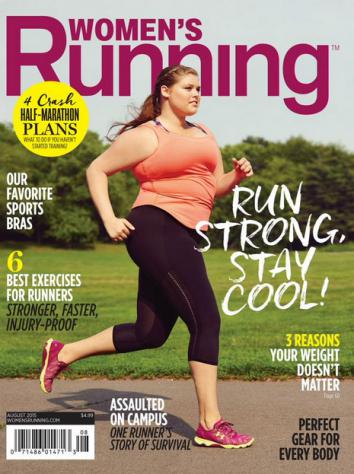I was at a party in a friend’s neighborhood a few weeks ago when I found myself talking with a guy from nearby. It came up over the course of our conversation that one of my primary hobbies is running. Upon discovering this, my interloper gave me a dubious look before responding, “Huh, you don’t look like a runner.”
I resisted the urge to throw my beer in his face or challenge him to wind sprints, but his comment still stung.
What does a runner look like anyway?
It should be common knowledge at this point that the contours of a woman’s body are not up for discussion, but when it comes to fitness and gym culture, fat shaming runs rampant. For many, fitness, unfortunately, gets intertwined with appearance, and it’s thus imperative that athletes “look” a certain way.
That’s why I’m excited to see the August issue of Women’s Running hit newsstands this week. The magazine’s cover features Erica Schenk, a plus-size model and runner who’s been at the sport for 10 years.
Seeing Schenk run, strong and confident, across that cover is a beautiful reminder that female runners come in all shapes and sizes. There is no single “look” of a runner and there needn’t be.
“Some women believe that since they have curves they can’t run or shouldn’t run,” Schenk told Women’s Running. “Running is for every body anytime.”
Sure, putting Schenk on the cover is an easy publicity grab for Women’s Running and a way to convert rah-rah body positivity into big bucks for a brand (one that’s likely lagging as most print magazines are these days). Plus, given that women, of all sizes, accounted for nearly two-thirds of the 18.8 million U.S. race finishers in 2014, it shouldn’t have taken so long to get this sort of representation in a magazine that’s explicitly about women’s running.
But representation is still important. Elite female athletes experience eating disorders at more than twice the rate of the average woman, according to the National Association of Anorexia Nervosa and Associated Eating Disorders. And among female high school and college runners, disordered eating is disturbingly common. Having a one-size-fits-all image of women who run is not only upsetting, it’s dangerous.
When we run, especially outdoors on these hot summer days, we’re putting our bodies on display. We’re choosing to be vulnerable for our sport and the numerous physical and mental benefits it offers. Having the very magazine that on previous covers boasted of ways to “Run Yourself Slim + Happy,” celebrated “Sexy Abs Fast!,” and offered “The 24-Hour Diet” finally acknowledge on its cover that “Your weight doesn’t matter” is a step toward making that vulnerability a little less scary.
One magazine cover isn’t a cure-all, but it is a reminder that I do look like a runner, because runners come in all stripes.
Besides, I’m pretty sure I could outrun that guy at the party anyway.
